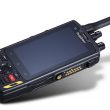Chip enables smaller RFID reader
While UHF radio frequency identification tags have decreased significantly in size and cost, the same has not been true for RFID readers in the band. However, Intel’s recent entrance into the space with its R1000 chip may help drive improvements in the size and cost of UHF RFID readers in all applications.
Intel’s R1000 is a complete transceiver that provides transmit/receive, modulation/demodulation and baseband functionality, and which also replaces more than 100 RF components valued at more than $100, said Kerry Krause, Intel’s director of marketing for RFID operations. In addition, the chip — in production at the beginning of April — includes low-power amplification for short-range applications and supports external power for longer-range applications, he said.
With longer range and faster read rates than RFID technologies in lower bands, UHF RFID has greater potential to serve the asset-tracking needs of enterprises at all levels, Krause said. UHF RFID tag prices “have dropped like a rock” during the past two years — due to the development of standards — reaching a commodity level at 7¢ per tag, he said.
“With maturing standards and cheap tags, the missing piece really was on the reader side,” Krause said. “With the Intel R1000, we’re taking the most expensive and complex part of today’s UHF readers — the radio — and integrating about ninety percent of the components into a single chip.”
This integration is enabling the development of smaller RFID modules and readers, said Bill Nuffer, president of Deister Electronic USA, which is using the Intel chip in its latest reader products.
“The most notable difference is in the module,” Nuffer said. “For example, within any given set of parameters, we’ve cut the size of those modules by one-third.”
This flexibility is significant, as the R1000 can serve as the building block for a variety of UHF RFID readers, from small hand-held devices — something that “just wasn’t feasible” before — to high-performance readers utilized on loading docks, Krause said.
“Historically, there had been some reader vendors that focused on one end or the other,” Krause said. “[The R1000] makes it easy for reader vendors to develop products for the full range of form factors.”
Indeed, Deister Electronic has demonstrated a short-range receiver about the size of a computer mouse and a dock-door reader using the same R1000 chip, Krause said. Being able to use the same chip technology for so many RFID readers will help simplify the application-development process for software vendors and make it easier for enterprise IT departments to manage RFID systems — all of which improves the economies of scale for the R1000.
Ultimately, such economies of scale are expected to generate considerable cost savings, although they are not part of the equation immediately, Nuffer said.
“Clearly, [the price of an RFID reader using the R1000 is] going to be less, but in the short term — within six months — the cost is going to be similar,” he said. “Long term, our expectation is that the price would be cut roughly in half.”
With large-scale production of R1000 chips under way, products utilizing the technology should be on the market soon, Krause said.
“We have about ten manufacturers that will be shipping R1000 products by the end of the second quarter,” he said. “We have an additional twenty customers scheduled to launch products in the second half of the year.”












